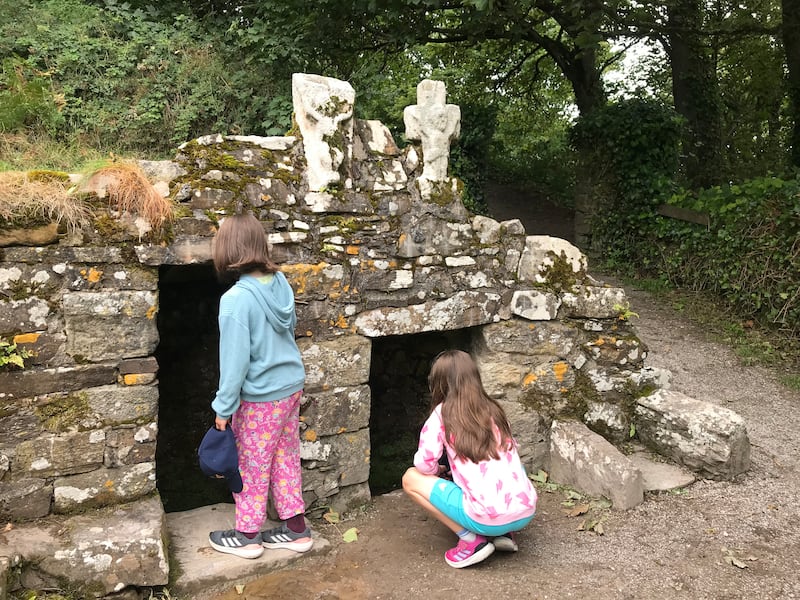During the Covid-19 pandemic, St Finian’s holy well on the Iveragh peninsula in Co Kerry became a place of pilgrimage for many people. The sixth-century saint, after whom the well was named, had a reputation for protecting people from the bubonic plague (also known as the Black Death due to the black blotches caused by subcutaneous haemorrhages). So perhaps it’s not surprising that comfort and sustenance was again sought in a sacred spot during what was, for many, the first pandemic in their lifetimes.
The curative powers of holy wells in Ireland are documented in heritage and folklore texts backed up by local accounts linking specific wells to healing everything from colds, sore throats, earaches, headaches, toothaches, warts and eye conditions to rheumatism, arthritis, general aches and pains and neuralgia. Some people believe particular wells bring benefits to mental health. The rituals involve people bathing in the water, dabbing the water directly on the ailment or drinking small quantities of water from the holy well.
Curious about whether the chemical properties of the water in holy wells in Ireland were linked to the various cures associated with specific wells, hydrogeologist Bruce Misstear undertook a comprehensive study of more than 200 holy wells in Ireland in the late 2010s.
“I had worked in consultancy on groundwater developments in many countries and moved into academia in my early 40s, so in the years approaching my retirement I decided to do a PhD in the hydrogeology of Irish holy wells,” says Misstear, who taught hydrogeology and environmental engineering at Trinity College Dublin for more than 25 years.
RM Block
Already having a casual interest in visiting some of the estimated 2,000 extant holy wells in Ireland, Misstear – ably assisted by his wife, Gillian Misstear – investigated both the geological landscapes where holy wells are found and the water chemistry of holy wells.
“I wanted to find out if holy wells were more common in certain geological landscapes, if the water chemistry was different in holy wells to other wells and if the water chemistry is linked to the reputed health cures,” says Misstear, who wrote Wells and Wellbeing – the Hydrogeology of Irish Holy Wells (Geological Survey Ireland) following the completion of his PhD.
In his research, Misstear found the rock structure – limestone, metamorphic rock or igneous rock – does not determine the frequency of holy wells in Ireland but the precise location of holy well is determined by the springs or seepages from groundwater. In chemical terms, groundwater is often relatively mineralised compared with surface water and so can provide useful dietary contributions of bio-essential elements such as calcium, magnesium and iron.

“The water in limestone areas is enriched with calcium bicarbonate [lime] whereas the water in igneous and metamorphic rocks tends to be softer,” says Misstear.
Following a detailed geochemical analysis of the water in more than 200 holy wells, Misstear concluded that the water chemistry in holy wells was broadly what he expected to find in other shallow springs. “I found very few correlations between the reputed cures and the concentrations of chemical constituents of the water,” he says.
Digging deeper into his findings, however, he discovered that some of the holy wells most associated with curing eye conditions were closer to the sea and had slightly higher concentrations of dissolved sodium chloride (salt).
“If you consider that you might use a saline solution to wash out an irritation in the eye, this is interesting but the concentrations were still very low compared to those in an eye wash solution,” says Misstear. He adds that cures for ailments of the eyes were associated with more holy wells than any other ailment he surveyed (see figure on most common cures associated with holy wells) and surmises that eye irritations were undoubtedly common in poorly ventilated homes where turf and wood was used for cooking and heating.
Misstear cautions visitors to holy wells to not assume that the water is potable, particularly at times of heavy rainfall or run-off from nearby agricultural land.
“One of the few previous scientific studies of water quality in holy wells was in Austria which found that many of the springs were contaminated with faecal bacteria and about 20 per cent of the samples had nitrate concentrations above the European Union’s drinking water standard,” he says. In Ireland, some local authorities have put up signs warning people against drinking the water in some holy wells.
And while his overall findings didn’t scientifically validate the folk cures associated with Irish holy wells, his analysis of the water chemistry of at Tobar na nGealt (well of the lunatics) in Co Kerry confirmed earlier findings by Brendan Kelly, professor of psychiatry at TCD, that the levels of lithium were far below any therapeutic levels. Lithium is a mood stabiliser medication used to treat certain mental health conditions.
“There are many stories of people seeking cures for mental health ailments by drinking water from this source (and sometimes eating local watercress) and an elevated lithium value for the spring water was reported during a TG4 television programme in 2012, leading to speculation about the possible links between this lithium content and the reputed cure,” says Misstear. However, both Kelly and Misstear’s analyses found the concentrations of lithium at Tobar na nGealt were too low to have any detectable therapeutic benefits at an individual level.
While holy wells are protected under national monuments legislation, it is estimated that about 1,000 of the original 3,000 wells mapped in the 19th-century ordnance survey no longer exist
Despite these perhaps disappointing findings – that the science doesn’t back up the folk cures associated with holy wells, Misstear, like many others before him, concludes the cultural value of holy wells in so-called therapeutic landscapes shouldn’t be discounted.
“One of the reasons I became a hydrogeologist was the links between springs and valleys, trees and stones, graveyards and churches. And researching my book – which I called Wells and Wellbeing – we found attractive wells in remote places which gave us a sense of feeling good. We saw parts of Ireland that we didn’t know existed,” he says.
He cites Tobernault (well of the glen) holy well in Carraroe, Co Sligo, St Declan’s holy well in Toor, Co Waterford, and St Kee’s Well in Foohagh, West End, Co Clare, among his favourite holy wells in Ireland. Toberaheena (Friday’s Well) near Clonmel, Co Tipperary, next to a small stream within a garden has been renovated as a quiet space for people bereaved by suicide – which Misstear cites as a good example of the adoption of a holy well site as a therapeutic landscape.
Misstear would also like to see greater protection for holy wells in Ireland and is enthusiastic about recent archaeological surveys of holy wells in some counties. The Heritage Council’s recent publication Holy Wells in Ireland and renewed interest in the schools’ collection in the National Folklore Collection (duchas.ie) have confirmed people are interest in both the history and geography of Irish holy wells.
While holy wells are protected under national monuments legislation, it is estimated that about 1,000 of the original 3,000 wells mapped in the 19th-century ordnance survey no longer exist. Misstear suggests that if more holy wells were designated on county geological sites, people might become more aware of them and therefore seek better protection of them.
“There are about nine holy wells designated in county geological sites, which means that they are included in county development plans. I think it would be useful to designate more of them as county geological sites to raise awareness of them. Including some holy wells as Natural Heritage Areas would also be a way of helping to further protect them against adverse impacts in the future,” he adds.
- Listen to our Inside Politics Podcast for the latest analysis and chat
- Sign up for push alerts and have the best news, analysis and comment delivered directly to your phone
- Find The Irish Times on WhatsApp and stay up to date




















